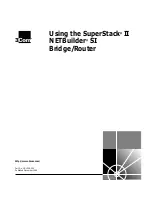
1 Product Overview
Quidway NetEngine20/20E
Configuration Guide - Basic Configurations
1-14
Huawei Proprietary and Confidential
Copyright © Huawei Technologies Co., Ltd.
Issue 05 (2010-01-30)
z
Perform centralized management over the routes discovered by these protocols.
z
Provide varying routing policies, implementing sharing of routes discovered by both
static and dynamic routing protocols.
In networking practice, the routing table is always large, while the memory of the router is
limited. To ease this contradiction, the NE20/20E provides a size control mechanism for
routing tables. It monitors the current free memory of the system, based on which it decides
whether to add routes to the routing table and whether to keep the connection of the routing
protocol.
Besides, the NE20/20E supports load sharing and route backup functions.
1.3.9 Multicast Routing Protocols
IGMP
The NE20/20E supports the Internet Group Management Protocol (IGMP) that is used to
establish and maintain the multicast members between the IP host and the directly connected
multicast routers.
Various Multicast Routing Protocols
The NE20/20E supports various multicast routing protocols as follows:
z
Protocol Independent Multicast-Dense Mode (PIM-DM) and Protocol Independent
Multicast-Sparse Mode (PIM-SM) that are used in the same area
z
Multicast Source Discovery Protocol (MSDP) and Multi-protocol Border Gateway
Protocol (MBGP) that are used between areas
1.3.10 MPLS Features
The Multiprotocol Label Switching (MPLS) uses short labels with fixed length to encapsulate
network layer packets, and it can:
z
Act as an intermediate layer between the network and link layers.
z
Provide connection-oriented network services through the services obtained from the
link layer protocols such as PPP and FR.
The NE20/20E forms forwarding equivalence classes (FECs) based on such information as IP
address prefix, and perform the role as below:
z
Generates label forwarding table.
z
Forwards information traffics of different FECs (with different label fields in the headers)
through the different label switch paths (LSPs).
The MPLS supports the following:
z
Policy-and-constraint-based routing (such as limitations formed in accordance with the
VPN and Diff-Serv) on LSPs, which enables you to freely select a router from the MPLS
network to establish an LSP.
z
LSP tunneling technology and maintains a label stack at both the ingress and egress of a
tunnel to carry out tunnel nesting and to fit into different application requirements.
The MPLS functions of the NE20/20E are:
z
Accelerate packet forwarding to a great extent.
















































